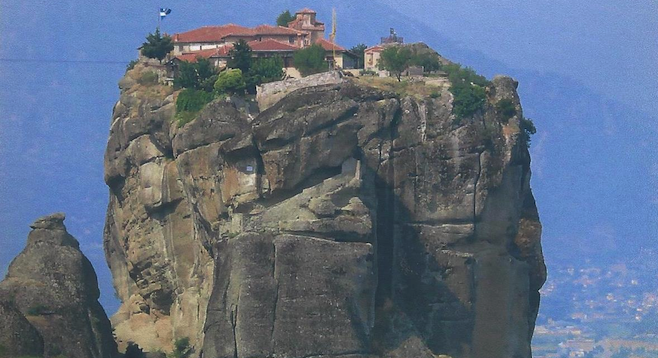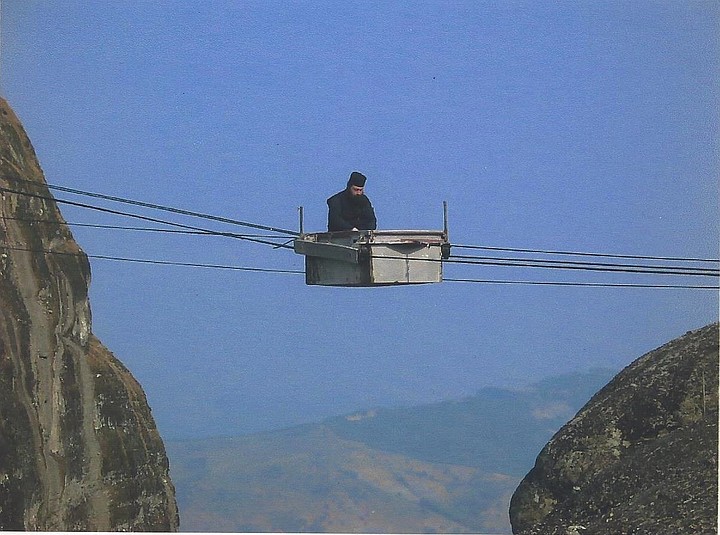 Facebook
Facebook
 X
X
 Instagram
Instagram
 TikTok
TikTok
 Youtube
Youtube

In the mountainous interior of Greece near Meteora, gigantic granite outcroppings, most of them topped with Christian monasteries, point skyward like fingers tipped in prayer.

They are a stone’s throw from the pass of Thermopylae, where 300 Spartans defined their name in a last stand against 10,000 Persian mercenaries. Local life has changed little since those ancient halcyon days.
I 'd heard a story about an orthodox priest who had forsaken the outer world to pursue a life of quiet contemplation fueled by art rather than prayer – or rather, to his way of thinking, art that was prayer. I had been told he painted like Raphael and that those who knew him shielded him from outside influences, allowing him complete immersion in his personal form of worship. Such a man, if he even existed, would be difficult to find.
But then we met George, the taxi driver.
George caught us completely off guard by answering our by now-redundant search question with “You mean Father Pefkis?"
According to George, the good father was a holy man who worshipped God through his work, creating only religious icons that he considered to be prayer carriers, a direct line to the Almighty, if you will. He also told us the priest had qualities that could not be explained by rational means, and added, “You will find out. He will know before you arrive whether you are seekers or tourists.”
That is why I began to wonder if we were victims of a hoax when the next day, after a long drive, he deposited us at a rickety auto mechanic’s shop next to a roadside diner and motioned us up the stairs. The well was so dark the single bare bulb stole our night vision until I pushed the door at the top open and was assaulted by a kaleidoscope of color.
It was a painting atelier the likes of which we had never encountered.
The walls were hung with icons, traditional religious scenes painted on wooden panels with gold leaf backgrounds and people isolated as the subject matter. There were hundreds of them and many more on easels in various states of progress. In that dimly lit room, the paintings seemed to carry a life of their own, glowing from within.
Whether one knows art or not, it provides a gut feeling when in the presence of greatness – like entering the Louvre or the Prado. Here, in a rickety attic over an auto repair shop, was an equal. My immediate thought was that we had entered a poor man’s Sistine Chapel.

While still trying to process what we were witnessing, I sensed, more than heard, a presence and turned to meet this master. He stepped forward, extending a hand, and as I took it a sensation washed over me that I was directly connected to the instrument that had given life to these epic works – that I was meeting a true Renaissance master no less towering than Giotto or Bernini.
He was slight of build, dressed in traditional garb of stovepipe hat, gold crucifix and long beard. His hands, crossed one over the other in front of him, were a gnarled roadmap of bulging veins, the mark of one who has done much physical labor. His face was serene, with black, piercing eyes that spoke louder than words. We had no common language and needed none as he proceeded to lead us about his studio, intimating with body language or a tilt of his head how his creative process worked.
At a corner band saw, the only apparent concession to the modern world, he showed how he cut the wood panels and then sanded them. This was followed by the application of multiple wafer-thin sheets of gold leaf, rubbed against his cheek and pressed onto the panel, using only natural body oils as an adhesive. As he did this, he closed his eyes and smiled, reminding me of how someone would caress a beloved pet.

A sweep of his hand took us to a low table of hand-tied horsehair brushes next to a rainbow selection of pigment jars, all personally ground with stone mortal and pestle. Next he broke an egg, separating the white from the yolk, and mixed the yellow with a small dab of water and a dash of pigment, a Renaissance technique known as tempera painting employed by old masters such as Titian and long out of vogue due to its delicate nature. Layer upon layer of thin glazes are applied to the panel, slowly building the luminescent colors that dazzle the viewer.
Finally he sat before an easel that held a panel with only a pencil sketch on it, motioning for us to join him. With only a few deft brush strokes a smiling Madonna sheltering the infant Christ child in her arms began to take shape. His movements were swift and sure, and an enigmatic smile played on his lips as he painted. With his unspoken language of art he revealed the mechanism behind his connection to the Almighty. Everything about this man made me feel that even though he was physically beside us and sharing his creative process, his total being was on an elevated spiritual plane.
The day passed without our noticing as we were as immersed in the work as the good father, who would occasionally emit a sigh of pleasure that told us the latest brush stroke had achieved its effect. A sinking sun and growling stomachs announced it was finally time for us to go. As we bid farewell, Father Pefkis bowed his head and said in very halting English, “Thank you for joining me.”
My wife and I both realized we'd just had the kind of day all travelers pray for but rarely receive. When we left, that finished icon came with us. It hangs in our home today, a constant living prayer that continues to remind us of such an experience.


In the mountainous interior of Greece near Meteora, gigantic granite outcroppings, most of them topped with Christian monasteries, point skyward like fingers tipped in prayer.

They are a stone’s throw from the pass of Thermopylae, where 300 Spartans defined their name in a last stand against 10,000 Persian mercenaries. Local life has changed little since those ancient halcyon days.
I 'd heard a story about an orthodox priest who had forsaken the outer world to pursue a life of quiet contemplation fueled by art rather than prayer – or rather, to his way of thinking, art that was prayer. I had been told he painted like Raphael and that those who knew him shielded him from outside influences, allowing him complete immersion in his personal form of worship. Such a man, if he even existed, would be difficult to find.
But then we met George, the taxi driver.
George caught us completely off guard by answering our by now-redundant search question with “You mean Father Pefkis?"
According to George, the good father was a holy man who worshipped God through his work, creating only religious icons that he considered to be prayer carriers, a direct line to the Almighty, if you will. He also told us the priest had qualities that could not be explained by rational means, and added, “You will find out. He will know before you arrive whether you are seekers or tourists.”
That is why I began to wonder if we were victims of a hoax when the next day, after a long drive, he deposited us at a rickety auto mechanic’s shop next to a roadside diner and motioned us up the stairs. The well was so dark the single bare bulb stole our night vision until I pushed the door at the top open and was assaulted by a kaleidoscope of color.
It was a painting atelier the likes of which we had never encountered.
The walls were hung with icons, traditional religious scenes painted on wooden panels with gold leaf backgrounds and people isolated as the subject matter. There were hundreds of them and many more on easels in various states of progress. In that dimly lit room, the paintings seemed to carry a life of their own, glowing from within.
Whether one knows art or not, it provides a gut feeling when in the presence of greatness – like entering the Louvre or the Prado. Here, in a rickety attic over an auto repair shop, was an equal. My immediate thought was that we had entered a poor man’s Sistine Chapel.

While still trying to process what we were witnessing, I sensed, more than heard, a presence and turned to meet this master. He stepped forward, extending a hand, and as I took it a sensation washed over me that I was directly connected to the instrument that had given life to these epic works – that I was meeting a true Renaissance master no less towering than Giotto or Bernini.
He was slight of build, dressed in traditional garb of stovepipe hat, gold crucifix and long beard. His hands, crossed one over the other in front of him, were a gnarled roadmap of bulging veins, the mark of one who has done much physical labor. His face was serene, with black, piercing eyes that spoke louder than words. We had no common language and needed none as he proceeded to lead us about his studio, intimating with body language or a tilt of his head how his creative process worked.
At a corner band saw, the only apparent concession to the modern world, he showed how he cut the wood panels and then sanded them. This was followed by the application of multiple wafer-thin sheets of gold leaf, rubbed against his cheek and pressed onto the panel, using only natural body oils as an adhesive. As he did this, he closed his eyes and smiled, reminding me of how someone would caress a beloved pet.

A sweep of his hand took us to a low table of hand-tied horsehair brushes next to a rainbow selection of pigment jars, all personally ground with stone mortal and pestle. Next he broke an egg, separating the white from the yolk, and mixed the yellow with a small dab of water and a dash of pigment, a Renaissance technique known as tempera painting employed by old masters such as Titian and long out of vogue due to its delicate nature. Layer upon layer of thin glazes are applied to the panel, slowly building the luminescent colors that dazzle the viewer.
Finally he sat before an easel that held a panel with only a pencil sketch on it, motioning for us to join him. With only a few deft brush strokes a smiling Madonna sheltering the infant Christ child in her arms began to take shape. His movements were swift and sure, and an enigmatic smile played on his lips as he painted. With his unspoken language of art he revealed the mechanism behind his connection to the Almighty. Everything about this man made me feel that even though he was physically beside us and sharing his creative process, his total being was on an elevated spiritual plane.
The day passed without our noticing as we were as immersed in the work as the good father, who would occasionally emit a sigh of pleasure that told us the latest brush stroke had achieved its effect. A sinking sun and growling stomachs announced it was finally time for us to go. As we bid farewell, Father Pefkis bowed his head and said in very halting English, “Thank you for joining me.”
My wife and I both realized we'd just had the kind of day all travelers pray for but rarely receive. When we left, that finished icon came with us. It hangs in our home today, a constant living prayer that continues to remind us of such an experience.
Comments